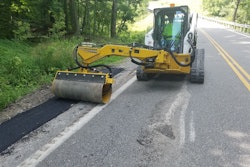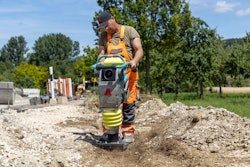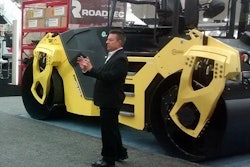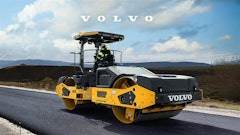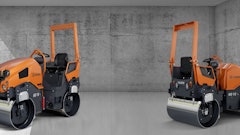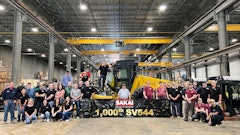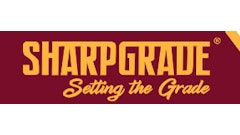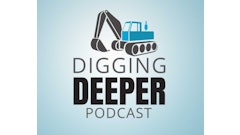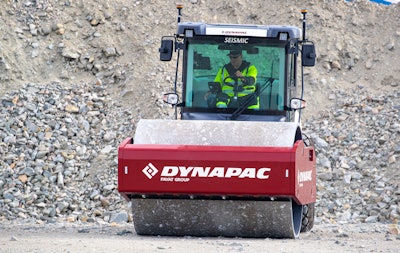
When it comes to compaction equipment, one thing is certain: Rental companies need to be up to date on the latest technology trends to ensure their equipment is ready for action when customers come knocking.
With that in mind, Brandon Fredricks, product manager for Milwaukee Tool, and Eric Booth, product marketing manager for compaction at Dynapac, roll out the latest trends in compaction.
Electrification
Perhaps one of the most significant advancements in compaction equipment is the introduction of battery and motor technology, Fredricks says.
“Battery technology focused on capacity, power, weight, thermal capabilities and recharge times is advancing rapidly and allowing light construction equipment to be battery powered,” Fredricks says. “These advancements are closing the gap between the power and run time of gas and corded equipment. There are many advantages battery-powered compactors provide, like instant power and more precise speed control.”
Booth agrees.
“Alternative power is a big deal, not just in offroad equipment but in general,” Booth says. “The rental market is ideal for that because of the smaller size of the rollers.”
Booth adds that emissions regulations, such as those developed by the California Air Resources Board, are a driving force behind the battery-powered trend.
“In the construction industry, pretty much everything is diesel, and those traditionally have higher emissions than gasoline engines,” Booth says. “When you have an electric engine, it’s just like an electric car—it’s quieter.”
Fredricks adds that frustrations and hassles with gas equipment and the need for indoor-use machines have also contributed to the uptick in electrification with compaction equipment.
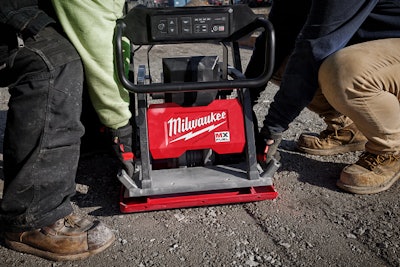 Battery-powered compaction equipment is becoming more relevant in the rental industry.Milwaukee Tool
Battery-powered compaction equipment is becoming more relevant in the rental industry.Milwaukee Tool
“Engine issues related to gas and starting delays significantly contribute to plate compactor downtime on a jobsite,” Fredricks says. “Advancements in building construction, like tilt-up and precast construction, are driving more indoor compaction opportunities. This requires companies to install expensive ventilation systems on jobsites or add expensive aftermarket emissions scrubbers. Battery-powered equipment eliminates the need to rent expensive jobsite ventilation systems or aftermarket emissions scrubbers that may not eliminate emissions and risk stopping compaction productivity if an air quality monitor alarm sounds.”
Additionally, with battery technology, users no longer need to prime, choke, pull and pull an engine, and there are no concerns about mixing fuel or putting bad fuel into a tank.
Booth acknowledges that electric machines are more expensive upfront, but rental companies can typically find incentives to bring down the price point.
“We’re seeing more and more incentives for companies to use alternative power. In some places, you can get a voucher system to make it cheaper to acquire the material,” Booth says. “In places that don’t have a voucher system, they get a bid incentive, where they get a 15 percent credit on their bid.”
To educate customers on the benefits of battery power, Fredricks recommends uncovering the size and scope of their jobs through qualifying questions.
“While battery-powered equipment often matches the power output and performance of gasoline-equivalent products, some companies are hesitant to make the switch,” Fredricks says. “Combining this discussion with an understanding of the run time and uptime and how many batteries are needed before the next battery is fully charged will help determine how many batteries and chargers a user might need for a large job.”
Booth notes that some fear that battery-powered equipment doesn’t provide the same performance as other fuel sources.
“With our rollers, you’re getting the same type of performance metrics that you need—you’re just getting it from a different power source,” Booth says.
Before rental houses invest in battery-powered compaction equipment, Fredricks warns that not all battery systems are created equal.
“As rental yards begin to evaluate and add battery-powered equipment into their fleet, it is essential to assess the battery systems they are investing in and not just the individual pieces of equipment,” Fredricks says. “The more products a rental yard can offer on the same battery system, the more utilization and return on investment they can expect to get out of a smaller number of batteries.”
Before buying a battery-powered plate compactor, or any piece of battery-powered rental equipment, rental yards should ask themselves:
- Are there other products on this battery system I can rent today and get more utilization out of my battery and charger investments?
- Will there be more products on this battery system in the future that will continue to help me significantly utilize my same batteries and chargers?
- Do I have confidence this battery system will be supported in the future?
SEISMIC technology
Another trend rental companies should keep an eye out for involves SEISMIC technology.
“Compaction is all about removing air voids out of the material, whether it be dirt, mud or asphalt,” Booth says. “When it comes to rollers, you have vibration, which consists of amplitude (how high the drum goes up and down) and frequency (how fast the drum moves). Traditionally, in soil, you set a high vibrations per minute, and you set the amplitude to low.”
SEISMIC technology, Booth says, includes a sensor inside of the drum that works with the natural frequency of the material that the operator is compacting. In other words, it reads what the optimal frequency is going to be.
“So, if you're compacting on dirt, there's a different natural frequency than what it would be for stones,” Booth says. “Each substrate has its own natural frequency to it, and when you have somebody who's rolling a large space, they keep hitting it until they get to a certain density. They just hit it hard until they think they’re done. With SEISMIC technology, instead of just hitting any type of soil with the same frequency, it's reading what the frequency is needed for that specific soil type.”
In turn, SEISMIC technology can help the operator reduce the number of passes, saving construction companies time, money and fuel.
“For the people who are running those machines, there's a finite amount of time that they have, so being able to get the job done quicker is going to is helpful to them and get them to the next job,” Booth says. “Long term, there’s less fuel consumption and the machine has a lower operating cost because there’s less wear and tear on it.”
Simple rollers
Compaction tools that are less flashy and less expensive have gained traction in the industry as well, Booth says.
“People that are coming in and renting these just want a traditional roller that’s still high quality but at a lower price point,” Booth says.
For end users who are looking for something basic, Booth notes that this is just one more option that rental companies can store in their fleets.





